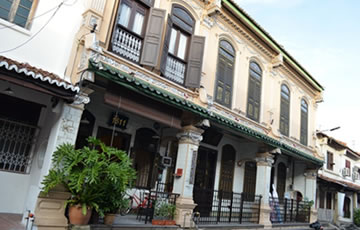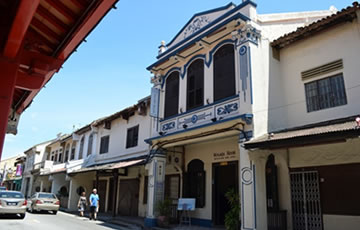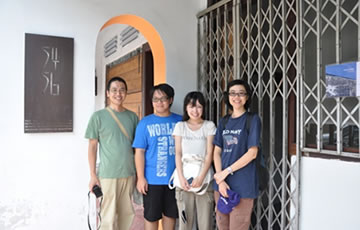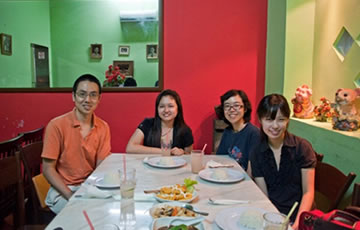研究活動
Particle Measurement in the Void Space of Tegal Experimental House.
Identifying and understanding how air moves from one room to another is an essential part of designing a sustainable building. By doing so, architects can maximize the air change and ventilation in the room and the building itself, especially in a double-loaded building type commonly built in developing countries. Therefore, this year, we experimented to see how particles move from a vertical void room to the housing units in the experimental house in Tegal, Indonesia. This building is unique for its closed vertical void space, which makes this measurement essential to understanding and improving the air quality and building performance of apartments in developing countries, especially Indonesia. We started by closing the opening of the void space on the second floor upwards. We filled and equalized the air inside of the void space with particles from fog machine, which after the conditions met, we opened the ventilation system and the opening of the void space. The difference between inside the room and the void space are compared to see how much of the particle moved from void space into the residential units. In total we did 26 measurements with five different scenarios of ventilations. It was a challenging measurement, but we believe we will learn something and apply what we found in the improvement of building performance into more sustainable life in the future.
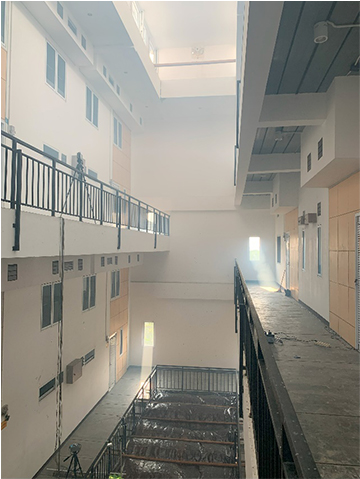
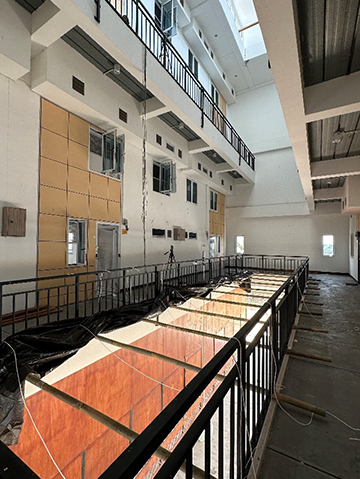
Low-Carbon Affordable Houses for Sustainable Society Seminar in Semarang, Indonesia.
The best part of learning is sharing what we know, Vaughn Lauer stated. Therefore, from 5th – 6th September 2023, we would not miss the opportunity to join a seminar where we can share and learn more, especially when the topic of the seminar is sustainability. The seminar is sponsored by Indonesia's Ministry of Public Works and Hiroshima University Graduate School of Advanced Science and Engineering, focusing on the progress of the SATREPS project to Indonesian government officials, and worked towards the final standardization of low-carbon housing complexes. The seminar was opened by the director of the ministry of Pekerjaan Umum dan Perumahan Rakyat (PURP), Ir. Dian Irawati, M.T, followed by keynote speakers and research presentations. Each group of our research topics were presenting, (1) indoor air quality in urban houses, (2) passive cooling for apartment buildings, and (3) life cycle energy and CO2 in apartments. Research members from other universities and institutions were joining the seminar, both from Indonesian side and Japan side. Each member of the project presented their interesting and conscientious research progress, which made the audience actively involve in the discussion session. The seminar was closed by a nice dinner with a night view of Semarang city and a visitation to old city area of Semarang.
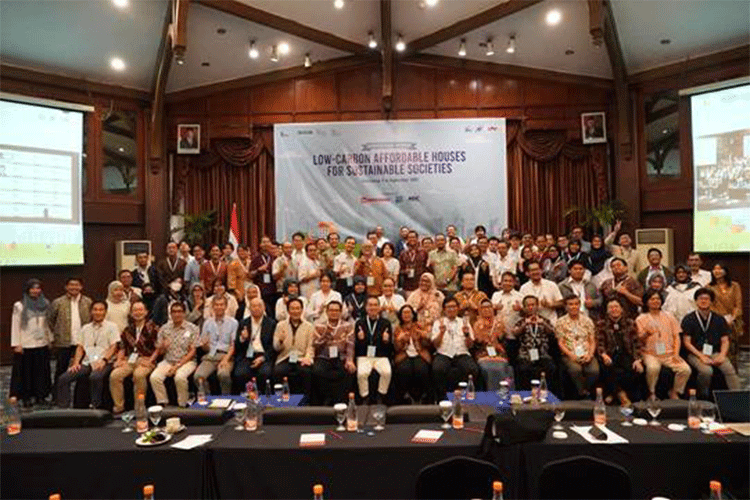
Get Started Now! (STAFF)
This April, 2022 Buesa Lab had the addition of new members! 5 undergraduate students, 4 graduate students, and 1 post-doctor. Furthermore, due to immigration restrictions, the three international students who participated remotely were finally able to come to Japan! This year, all surveys will finally begin in earnest.
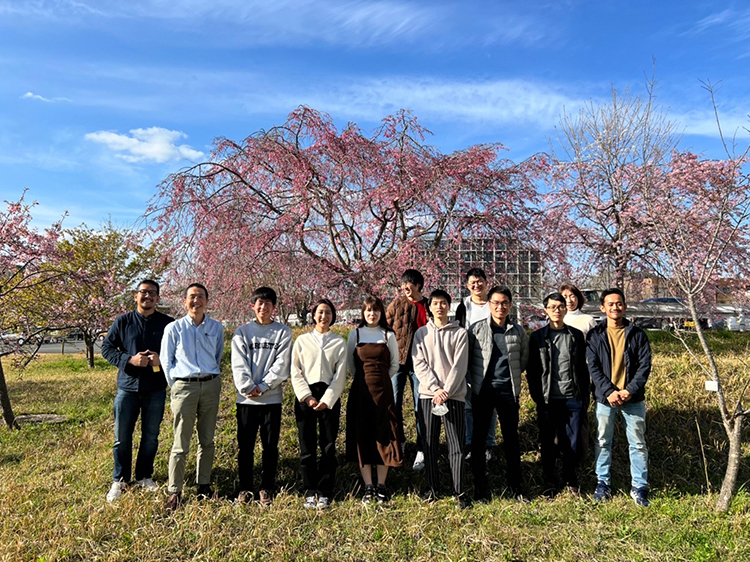
Congratulations! (STAFF)
Diploma-awarding ceremony was held on Wednesday, March 23, 2022, and two undergraduate students were conferred diplomas from Buesa Lab. I was reminded of how hard these 2 students had worked, just as if it was yesterday. Each of their paths will be different, but I hope that they can make a leap forward based on the days of studying in the same laboratory.
Silent start (by Tetsu)
This is our first time to welcome new students silently without giving any gatherings. We now accepted two undergraduate students newly, Takahashi and Sakita. The influence from the COVID-19 is spreading day by day even in Hiroshima. Our university is still barely open but we are now highly advised to conduct lectures online. There are much less students inside the campus now. Even under such very unusual emergency situation, we should go ahead as much as we can. Otherwise, the whole economy will be halted completely. Now we have 13 students in total of which 3 students are quarantined in overseas. It is really unusual circumstances. We are now doing research meetings in five groups online including (1) effect of void, (2) window systems for the tropics, (3) indoor air quality, (4) thermal comfort, and (5) life cycle assessment.
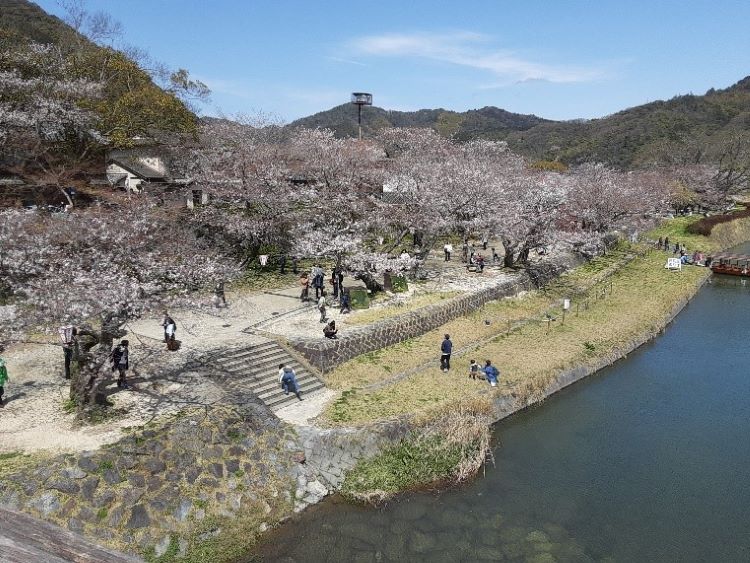
Opening ceremony for Tegal experimental house (by Tetsu)
We should have been there. The opening ceremony for the Tegal experimental house was held on 12 March. A number of guests were invited by the Tegal local authority to celebrate the completion of our experimental house. We intended to join it, but due to the COVID-19, we had to cancel the visit in the last minute. Anyway, the ceremony was quite successful and the building was now accepted by the local community. From the distant place, Hiroshima, I really appreciate the corporation from all the stakeholders, in particular, PUPR, Puskim, Tegal local authority, and Institute Technology Bandung.
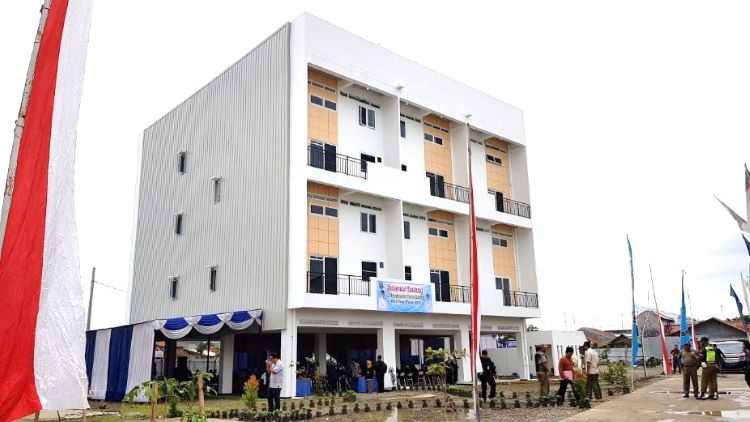
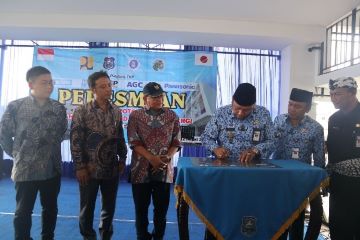

Diversity (by Tetsu)
I believe that diversity is a key for creative thinking. This is probably because we can think about a subject from different viewpoints. A sort of chemical reaction will happen in a diverse environment. This time, we receive six new students from four different countries, and maintain very diverse environment in terms of home country, culture, academic background and age as well. We are now a group of 21 members including me and three assistants, and we do research meetings in five different groups, namely (A) Effect of void, (B) Thermal comfort, (C) Windows for the tropics, (D) Kampongs and IAQ, and (E) LCA and QOL. Hiroshima is going to enter cold winter soon but our group discussion will heat up and warm the atmosphere.
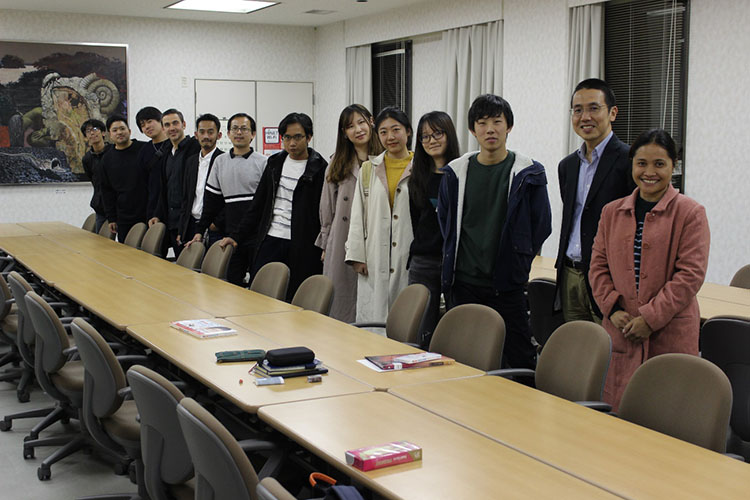
ILCA2030 (by Tetsu)
I had been in Bandung for about two months from September. Now we are preparing for the official start of the new project, SATREPS. One of the Japanese professors kindly gave us an abbreviation for our project, which is ILCA2030. This refers to the original project title “Implementation of low-emission affordable apartments in the hot-humid climate of Indonesia towards Paris agreement 2030”. We believe 2030 is so important because it is the target year for the Paris agreement. We aim to develop and propose new types of affordable low-carbon apartments for Indonesia towards the Paris agreement together with the local researchers in “ILCA2030”.
To be honest, I am not so sure how many presentations I made over the last two months in Indonesia. Almost every day, I went to somewhere in Bandung, Jakarta or even Tegal and enjoyed discussion with the local counterparts. Our project involves many stakeholders, including Puskim (main counterpart), central government, BMKG (methodological agency), Tegal local authority, and many local universities among others. We are very honored for such collaborations.
I also went to Tegal to observe the latest progress of the experimental house. I was really impressed to see its quality. The rooms are spacious and well ventilated with a sea breeze from the coast. The internal void space receives enough daylight from the roof-top, creating a nice semi-outdoor space inside. I got confident that this project will be completed in success. I really thank the contractor, ITB, Tegal and all the stakeholders involved in this project. The construction cost is fully provided by the Nichias Corporation, and we also received huge supports from YKKAP and AGC Corporation. This is going to place a significant milestone for our ambitious goal of low-carbon society in Indonesia.
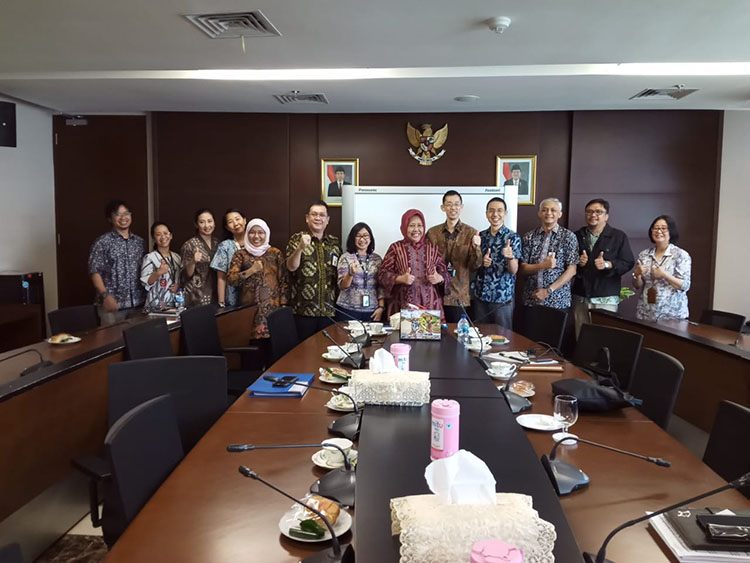
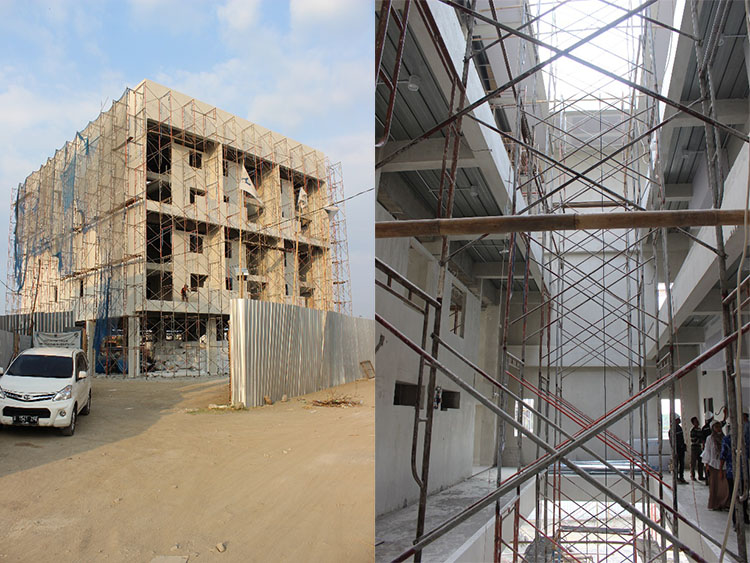
Wind tunnel experiments on ventilation effect of void spaces for low-cost apartments in the tropics (Wang)
In the rapid developing hot-humid countries, to maximize occupancy of apartment units, the number of the double-loaded apartment is found to be increasing. However, such double-loaded design causes poor ventilation both in the middle corridor and leeward side of the apartment due to the internal walls blocking the air from outside. Also, the lack of internal window drives occupants to rely more on the air-conditioning unit thus increases energy consumption. Our study aims to optimize the void design for a mid-high-rise apartment, allowing sufficient cross-ventilation.
At the beginning, we designed four different kinds of 1:75 scale acrylic models based on hundreds of actual samples gathered from existing Indonesian and Indian apartments. Next, we conducted wind tunnel experiments in Niigata Institute of Technology (NIT) last December 2018 to measure the accurate wind velocity and pressure data of the models.
The results of a wind tunnel test were used as baseline data to validate the Computational Fluid Dynamics (CFD) simulation. To obtain more accurate data in CFD, we did another wind tunnel experiment in NIT last June 2019 to improve validation results.
Wind tunnel experiment is precise but time-consuming and costly, while CFD simulation is an effective tool to adjust designs easily. With the experience of on-going research, we will be able to improve the more complex design of models to create better cross ventilation for hot-humid countries.
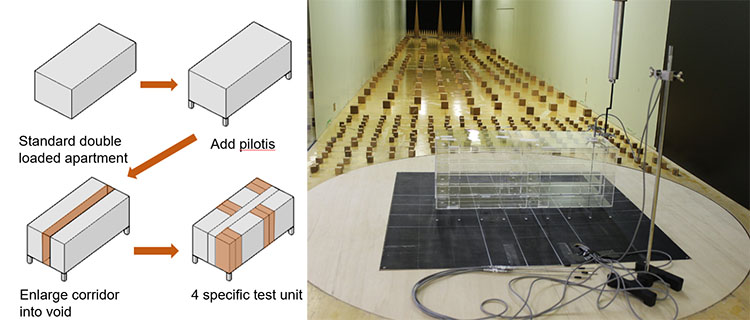
New start with Sakura (by Tetsu)
Japanese people cannot change the starting month from April. In Japan, most things start from spring with Sakura blossoms. We also had a good start with two new members, Cristiana and Hayato. We also have a good news. We have just obtained a huge research grant, which is called SATREPS (). This project aims to develop and propose new low-carbon affordable apartments in the hot-humid climate of Indonesia. We will expand our researches to a large extent for years to come!

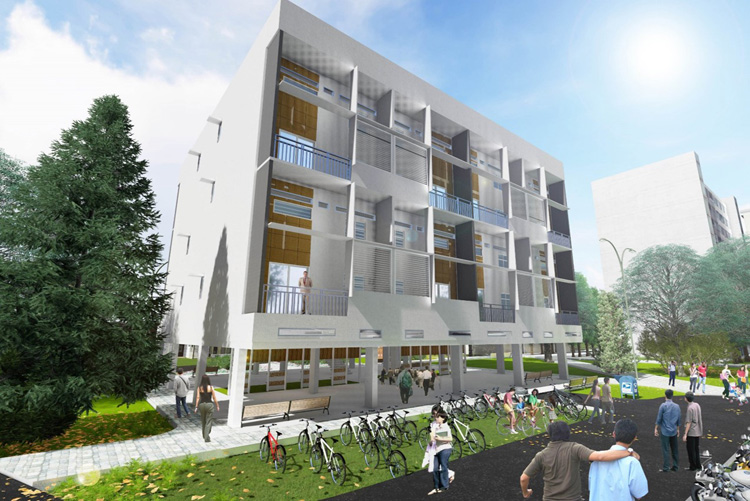
(Designed by Green Building Lab., ITB and BUESA, HU)
Pilot survey on Thermal Comfort and Workers Productivity in Davao Region, Philippines (by Gretchen)
Hot-humid climate such as the Philippines is vulnerable to the increasing temperature due to climate change. As reported by the International Panel on Climate Change (IPCC), impacts of global warming will be mostly be felt across human communities and economies.
The Micro, Small and Medium Enterprises (MSMEs) accounts for 99% of all the total establishments in the Philippines. Thus, those who are most likely to be affected by global warming are people working in various industries and are expose to environmental hazards in the workplace that can be detrimental to their health and work performance. Consequently, this could also affect business total productivity and could lead to loss of revenue.
As such, a pilot survey was conducted last March 12-27, 2019 in three major cities in Davao Region, Philippines. The purpose of the study is to analyze and identify the factors that influence workers productivity in relation to their work spaces.
Thirty three (33) enterprises participated in the survey. They were divided into 3 types of industry, namely; Food Processing, Metals and Engineering and Others. Business owners and managers and workers were interviewed about their perceptions about their present working condition, health, thermal comfort, the major factors that can contribute to workers productivity and the significant challenges and issues they experienced with regards to the working environment. Similarly, the demographic data of the enterprises and the workers were also asked.
After analyzing the data and results of the pilot survey, the author will be executing a large scale survey in August 2019 to validate the results.


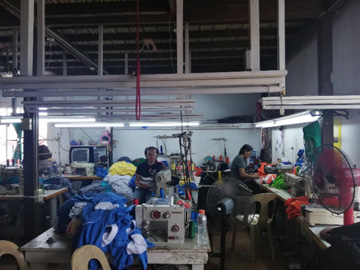

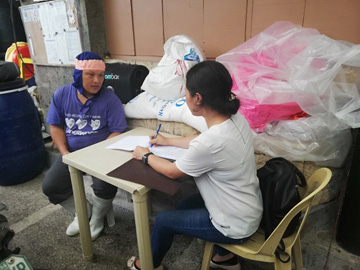
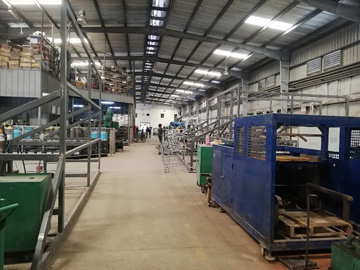
Development of radiant floor cooling system using phase change material under hot and humid climates (by Tanimoto)
Structure cooling by night ventilation is an effective cooling strategy to reduce peak indoor air temperature. However, in hot-humid climates such as in Indonesia, the thermal environment during daytime often cannot satisfy thermal comfort by the night ventilation alone. This study aims to develop a new radiant floor cooling system using phase change material (PCM) that can increase the structural cooling effects. PCM is a substance with high latent heat by melting or solidifying at a certain temperature. The main idea is to cool the floor structure through a forced ventilation for the attic space using PCM. During night time, PCM store the cool through solidification induced by the temperature difference between PCM and ambient air. And then, during daytime, PCMs melt and release the cool to the living space. The preliminary field experiment by experimental building was carried out on April 2019. In the measurement, the cooling effect of the proposed floor radiant cooling system was observed, and the maximum reduction of surface temperature of floor was up to 1.6°C. Now, the simulation analysis is ongoing, and the field measurement by full-scale experimental house will be carried out in 2020.

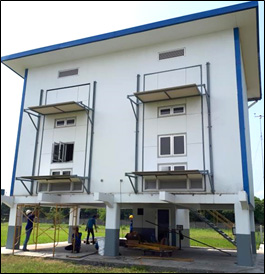
Field Investigation for Kampong Improvement Program in Bandung, Indonesia (by Kresna and Sumi)
While not fall under 'slum' category, kampong settlements are still evidently underdeveloped and unstandardized comparing to the more formally developed settlements in Indonesia (i.e. apartments, flats, formal housings). Setting our final objective to improve the health and quality of life in said settlements through building sciences, initial investigations in the physical condition of environments and its resident's health conditions related to sick building syndrome (SBS) need to be done as a base for recommendation measures.
Together with the Research Institute for Human Settlement and Housing Indonesia (Puskim), Indonesian Education University (UPI), and most importantly the residents of RW 6 kampong Pasteur, Bandung, we initialized a comprehensive physical measurement in a number of houses (34 non-detailed, 5 detailed) while subsequently conducting interviews to the residents related to SBS and behaviors in occupancy. The measurements were done in the late dry season (October – November 2018) and the rainy season (March – April 2019). At the same time, in collaboration with Puskim we also conducted similar initial measurements and questionnaire for pre-relocated kampong area in Semanggi riverbank, Solo city. The result is set to be compared with the area of relocation in newly build sub-communal housing after its occupations in early 2019. Next step for both Bandung and Solo city will be conducted in September – October 2019 to implement recommendation measures and comparing the physical condition of pre and post-relocation respectively.
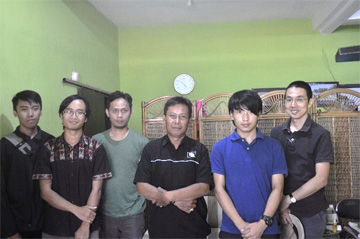
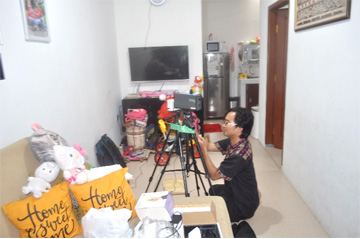
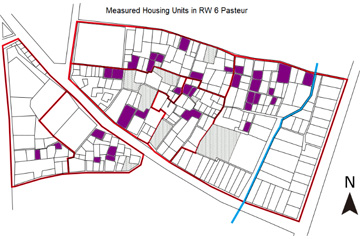

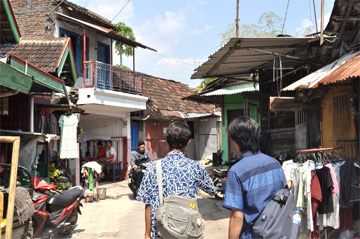
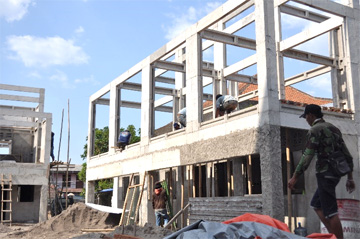
Indoor Air Quality and Its Effect on Health Survey in Surabaya and Jakarta, Indonesia (by Hanief)
Today, rapid urbanization in developing countries accelerates new constructions without regulating chemicals from building materials and minimum ventilation rates. This leads to a concern of the spread of so-called sick building syndrome (SBS). Therefore, it is important to investigate the current conditions of indoor air quality, especially formaldehyde and VOCs and their effects on the health of residents among urban houses in Indonesia. We mainly focus in newly constructed apartments, which emerge rapidly in major cities of Indonesia since 2010, but traditional landed houses, so-called Kampong, are also included for comparison. In the newly constructed apartments, it is assumed that residents face the problem of IAQ related with chemicals and reduced ventilation rates. In contrast, in Kampong, prolong rain and flooding during rainy season affect IAQ particularly in terms of mold growth and dampness.
There were three major cities measured in this survey, Surabaya, Jakarta and Bandung. Together with Sepuluh Nopember Institute of Technology (ITS) the survey of Kampong and apartment was done in Surabaya in September 2017 – February 2018. There were 471 respondents and 82 rooms measured from Kampongs and apartment. On the other hand, in Jakarta, the survey was done with Trisakti University and Podomoro University, there were 236 respondents and 81 rooms measured in apartment from August – October 2018. These surveys showed that there was a significant different of sensitivity risk in Kampong and apartment, there were houses that exceed the standard of formaldehyde and TVOC, and further analysis is needed to find the reason of those conditions. Currently the survey in Bandung is in progress and further measurement will be carried in September 2019.
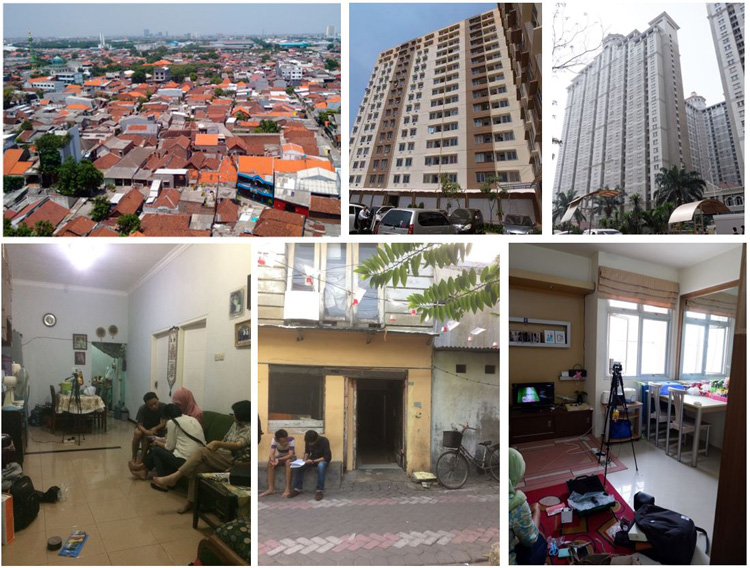
New Book is going to be published! (by Tetsu)
We are going to publish a book entitled "Sustainable Houses and Living in the Hot-Humid Climates of Asia" from Springer. Several BUESA works are included in the book. The summary of the book is as follows:
This book provides information on the latest research findings that are useful in the context of designing sustainable houses and living in rapidly growing Asian cities. The book is composed of seven parts, comprising a total of 50 chapters written by 53 authors from various countries, mainly in the Asian region. Part I introduces vernacular houses in different Asian countries such as Indonesia, Malaysia, India, Nepal, China, Thailand and Laos. Parts II and III then explore in depth indoor adaptive thermal comfort and occupants' adaptive behavior, focusing especially on those in hot-humid climates. Part IV presents detailed survey results on household energy consumption in various tropical Asian cities, while Part V analyses the indoor thermal conditions in both traditional houses and modern houses in these countries. Several real-world sustainable housing practices in Asian cities are reviewed in the following part. The final part then discusses the vulnerability of expanding Asian cities to climate change and urban heat island. Today, approximately 35-40% of global energy is consumed in Asia, and this percentage is expected to rise further. Energy consumption has increased, particularly in the residential sector, in line with the rapid rise of the middle class.
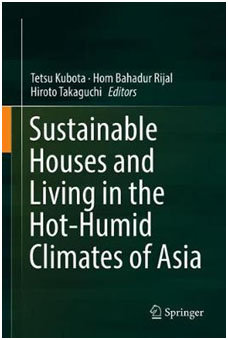
Cheers! (by Tetsu)
Now the world is probably in transition. We face many issues and confusions. We would like to drink to peace. Peace is the foundation for all the other things.
Let’s welcome five new members. They are Julia from Canada, and Sugiyama, Aoi, Martin and Ishibashi from Japan. In this semester, we maintain the five research groups as follows: (A) Energy-saving experimental house in Malaysia, (B) Traditional courtyard houses, (C) Energy-saving strategies for middle-class apartments in Indonesia, (D) Housing issues in developing world, and (E) Urban heat islands. Two PhD candidates are about to submit their theses!
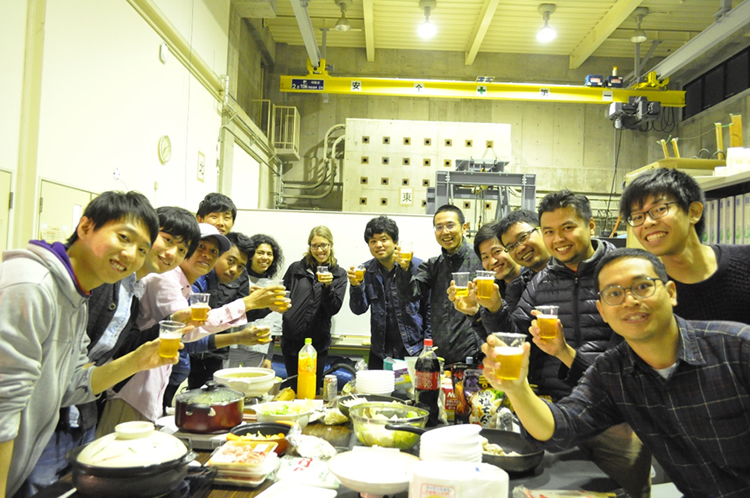
Field survey in Tashkent region, Uzbekistan (by Gulnora)
For the research concerning factors affecting energy consumption for space heating, a second (after a pilot survey conducted in April 2016), the main survey was carried out in January 2017. Four residential areas (including the capital city) varying in population, population density and surface relief were selected this time. Privately owned low-raise houses were the target.
 |
9. Tashkent city 4. Zangiota district 13. Yangiyul district 7. Parkent district |
Surveyed areas in the Tashkent region
With a generous support provided by the Tashkent region municipal government (Khokimiyat) we were able to collect rich data about occupants’ heating equipment, energy for space heating and thermal preferences in such a widespread questionnaire survey in a very limited time. An assistant from the local committee was provided in every visited residential area to ease the communication with householders.
In addition, a specialist from the Institute of energy and automation technology has helped us to carry out an energy audit of the randomly selected houses in Tashkent city and Parkent region. Analysis of collected information is in progress.

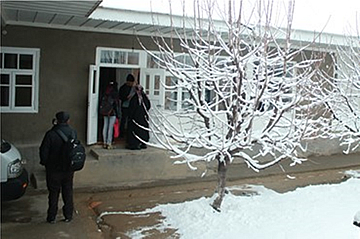
A Pilot Survey in Mindanao, Philippines (by Saidona)
At least fourteen housing rehabilitation sites were visited and eleven NGO implementers were interviewed in the provinces of North Cotabato, Maguindanao and Lanao del Sur, Mindanao, Philippines from February 18 to March 21, 2017 for the conduct of pilot survey.
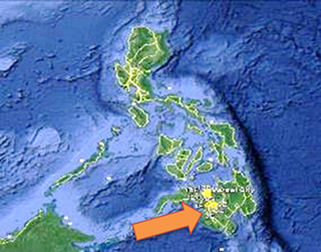
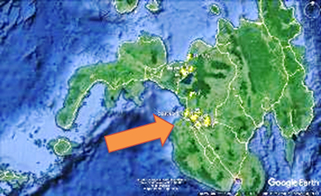

These rehabilitation sites are the one of the most conflict affected on 2000, 2003 and 2008 respectively which is must displacement of residents is occur repeatedly.
Rehabilitation implemented by some humanitarian organizations in the conflict-affected areas started since 2005. The area visited are ten (10) sites covered in Early Recovery and Rehabilitation in Central Mindanao (ERRCM); two (2) sites covered in Strengthening Response to Internal Displacement in Mindanao (Stride-Mindanao); one (1) site covered in GOP-UNDP, EC Program on Rehabilitating Internally Displaced Persons and Communities; and one (1) site covered in PAyapa at MAsaganang PamayaNAn (PAMANA). For security reason, we always coordinated to the community leaders before we conducted household interviews.
From the above areas visited, there are 84-housing owner were interviewed in terms of household profile such as household size, educational attainment, source of income, average monthly income, type of house before the conflict and what happen to their houses during the conflict. They are also asked about their perceptions on the housing rehabilitations in terms of size, materials and the performance such as services included and as well as their suggestions on the future rehabilitation.
The result of the pilot survey will provide general views from the beneficiaries in formulating the survey questionnaire on their satisfactions as basis in formulating policy and guidelines for the future rehabilitation program in the Bangsamoro areas.
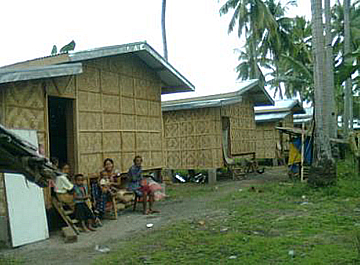

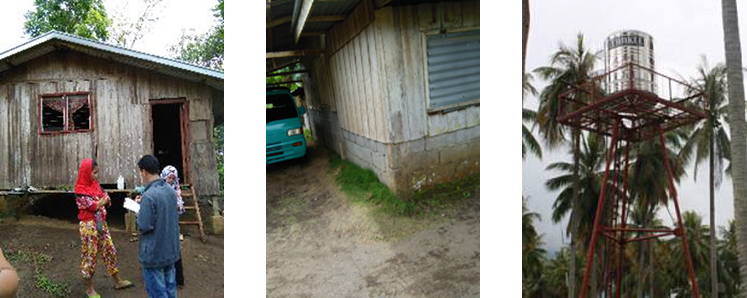
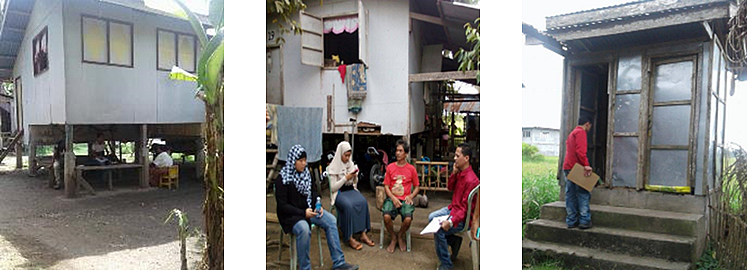
Kick off meeting and workshop for Indonesia project (by Ariel)
Eventually, the project of “Development of energy-saving standards for the middle-class apartments (Rusunami) in Indonesia” has officially been commenced. This commencement was signed by the kick-off meeting between BUESA, Hiroshima University (HU) and Research Institute for Human Settlements (Puskim), Indonesia in Bandung, Thursday, 29 March 2017. This meeting, actually was the follow-up meeting after Memorandum of Understanding (MoU) was concluded between the two parties in the last year (June 2016). Besides, PT. LAPI ITB also attended the meeting since they are the counterpart of this project. A total of twelve participants attended the meeting.
The meeting was opened by the Head of Department of Building Science (Puskim), Dr. Maryoko, and then followed by presentation by Dr. Tetsu Kubota and then Mr. Fefen Suhedi of Puskim. The meeting successfully discussed and concluded several agenda, such as research topics, budgeting, including land acquisition, and overall schedule. Each of the parties understood its roles, responsibilities and tasks in this project. Furthermore, the experimental building was determined to be developed in Semarang, the capital of Central Java Province. Before the kick-off meeting, BUESA team visited Semarang to see the construction site provided by Puskim. Some research agenda between HU and Puskim should be further synchronized in the future, since Puskim also will develop the similar big project, not apartment building but landed houses and housing complex.
After officially commenced, then, Puskim together with BUESA held a workshop on Friday 31 March 2017. One of the aims of workshop was to obtain the valuable comments or input from the scholars of Indonesia’s universities, such as from ITB Bandung, ITS Surabaya, UGM Yogyakarta, UAJY Yogyakarta, UB Malang, UPI Bandung, and so on, regarding the project. Around 18 participants attended the workshop including two representatives from YKK AP Indonesia.
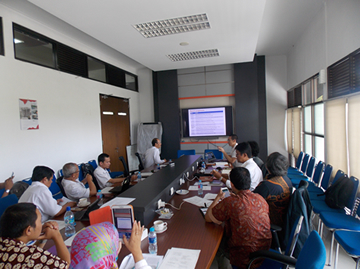
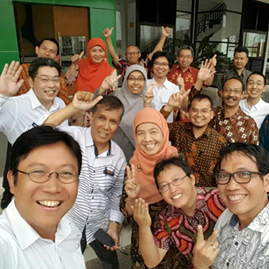
Situation of kick-off meeting (left) and after workshop (right)
The workshop was opened by Dr. Maryoko (Puskim) and then Dr. Tetsu Kubota and Ariel presented the current progress of project and research done by BUESA. After the presentation, there was very fruitful discussion amongst the participants. Every person gave opinions to the project, and some fresh idea came up during the workshop, such as the use of vertical shaft and centralized AC system with chilled water. And fortunately, all the invited scholars pleased to join the project and they were agreed to conduct separated researches in order to support the project.
Finally, in the last session, the participants were grouped into several clusters of research topics. There were seven clusters in this workshop, they are: Fundamental analysis; Occupant’s behavior; Thermal comfort; Indoor Environment; Health: Indoor Air Quality; Safety; and Design and Construction. They gathered according to the clusters where they interested in and then did focus group discussion to formulate the research topics, objectives and the methods. In the final stage, each clusters presented the results of focus group discussion.
Workshop was ended with the photo session ^^
Field survey in Tashkent region, Uzbekistan (by Gulnora)
Being the largest natural gas consumer (about 50% of a total consumption) in the country, residential buildings are the main target for energy efficiency improvements in order to support Uzbekistan’s economic growth and improving the welfare of citizens as energy sector is a major contributor to GDP and the largest export revenue generator.
While analyzing the driving forces of energy consumption it is reasonable to observe the relationship between building profile, household size, heating/ cooling systems and preferences. For this reason a field survey was conducted in April, 2016 in Tashkent region, Uzbekistan to get a closer view to the current condition of the privately owned houses. In total 10 different areas in 9 districts of Tashkent region were visited and 36 individual low-rise houses were examined by means of building size, materials, location and orientation, heating system and household profile. The owners were involved in a friendly talk to get more understanding about their energy usage awareness and level of satisfaction.

Visited areas in Tashkent region
The results of this survey will help to determine the target houses to carry on a measurements and further analysis going deeper through comparison of public and private houses in Tashkent region. I am most grateful for Kubota sensei’s guidance and support as well as all other participants who has helped me in this project.
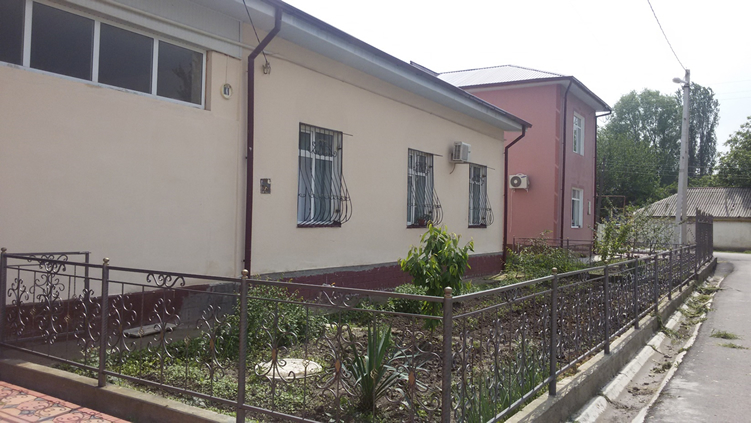
Facade of a house from the street

façade of a house from the courtyard
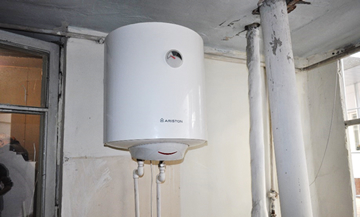
Electrical water heater
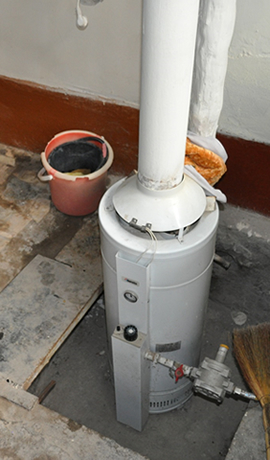
Heating system boiler works with a natural gas
A field measurement in Indonesia (by Nozoe)
From 29 August to 22 September 2016, a field measurement was conducted in Jakarta and Bandung, Indonesia.
The population in Indonesia as well as the number of middle class have been increasing in the last decades. Therefore, the number of apartments for middle class people is also increasing. Nevertheless, there are some problem in the established apartments such as: they are built without using insulations and shading devices, which resulted in bad ventilation and indoor thermal conditions. These lead to increasing energy consumption of air conditioner for cooling.
Our research aims to improve the thermal condition of apartments for middle class. Therefore, this investigation aims is to look for some passive techniques in the particular buildings in Indonesia, which later will be tested in the building simulation.
Our target buildings are: 1) Dutch colonial buildings, 2) Kampong houses, 3) Traditional houses in Taman Mini Indonesia Indah, and 4) Building’s material store.
Our methods include: 1) to measure air temperature and surface temperature, 2) to observe the characteristics of buildings, 3) to conduct questionnaire survey to buildings’ occupants.
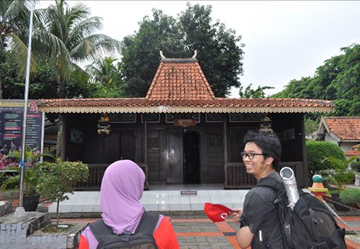

Indonesia traditional houses in Taman Mini Indonesia Indah
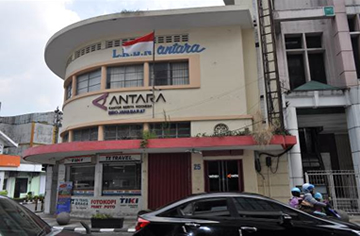

Dutch colonial buildings in Bandung
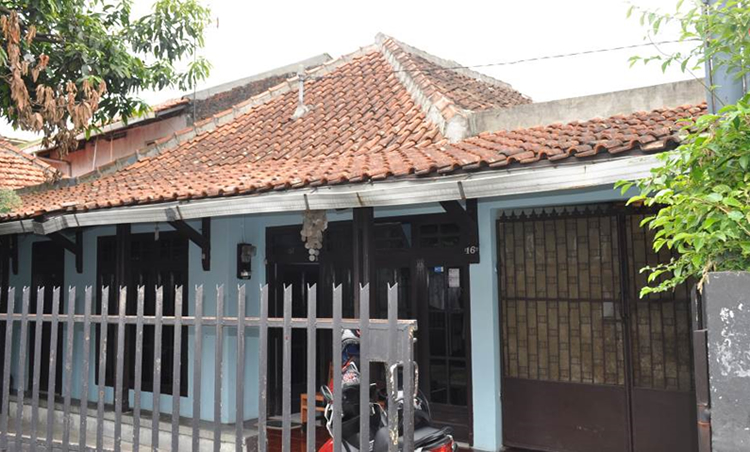
Kampong house in Bandung
Field measurement at Nichias Eco-house in 2016 (by Kanao and Sumida)
In September of this year, we visited UTM in Malaysia for a survey. As the effect of passive cooling techniques on indoor thermal comfort has been investigated at Nichias Eco-houses, this time we will focus on the effect on cooling load and energy consumption of air-conditioners. We newly installed internal insulation to one of the master bedrooms, now we can see the effect of external and internal insulation at the same time. Also we will apply other techniques, for example natural ventilation and forced ventilation as usual. Installation works were very tough therefore we are looking forward to obtaining good results at the end.
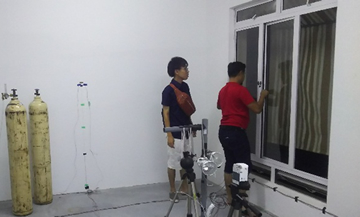

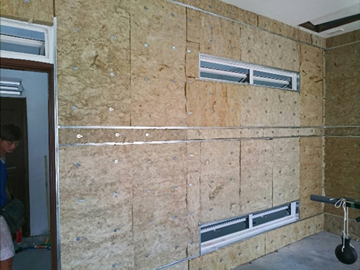
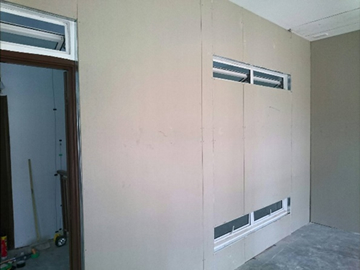
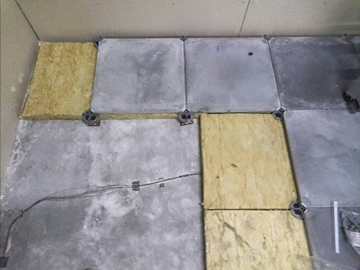
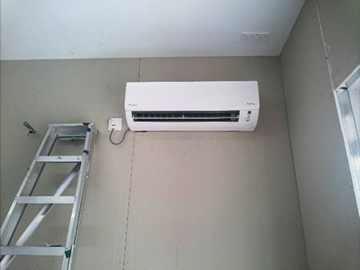
Field trip and data collection in Indonesia (by Ida)
This summer (2016), I visited Indonesia for the first time. This trip was a great experience. I was astonished the cultural differences. One of these is the sacrifice feast. This is one of the Muslim’s holidays celebrated each year. My senior, Mr. Andhang, took me to this event near his house with his father. I was terribly shocked to look this scene, because I haven’t ever seen the sacrificed animal such as goat and cow. I was reminded that life is sacred and life is to be valued.
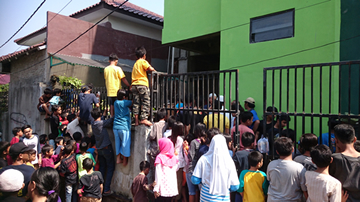

In the beginning of visit, I took part in Symposium on climate change in Bandung Institute of Technology (ITB). Here, I could have heard some presentations and learned some studies and meet great researchers.
This visit aims to obtain health data, weather data and socio-economic data in Bandung. After the symposium and meetings, I visited some institutions together with a student from ITB who accompanied me, Mr. Gerry. In the health agency, I met some staff who are very gentle, amusing and cooperative. There are some people who can speak Japanese too. In other institutions, I could have obtained many data thanks to Mr. Gerry. He also took me to his favorite restaurant which serves pork noodle.
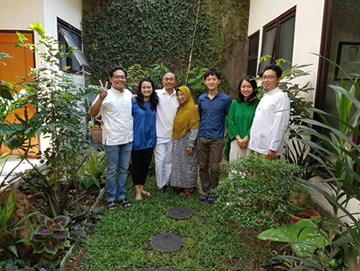
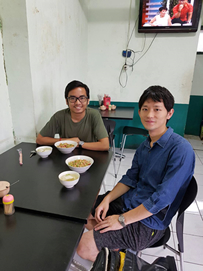
The opening ceremony of Nichias Eco-houses!
The experimental houses have finally taken shape! In early December 2015, an opening ceremony was held at the houses which are located inside the Universiti Teknologi Malaysia (UTM) campus in Skudai, Johor Bahru, Malaysia. The houses are a collaborative research project between Nichias Corporation, Institut Sultan Iskandar-Universiti Teknologi Malaysia (ISI-UTM), and Hiroshima University. The project has been named officially as Nichias Eco-houses.
The Nichias Eco-houses aims to develop passive cooling techniques in order to reduce energy consumption in housing, especially for the existing terraced houses in Malaysia. The final goal of the project is to develop a guideline for energy saving that will be proposed to the Malaysian government.
The opening ceremony marked the beginning of intensive study which will be carried out in the constructed houses under several phases. In the first phase, a field measurement had been conducted to obtain the thermal condition of the houses with and without the end wall insulation under several ventilation strategies. For the next phases, the houses will apply several passive cooling techniques and the resulted indoor thermal conditions will be measured. Through this experiment, we want to make the Nichias Eco-houses to be friendlier to the environment and could give a cooler experience for the resident without using an air conditioner.
The ceremony itself was such a memorable event! We were so glad that many people who had been involved in this project could attend. In the ceremony, Nichias Corp. was represented by Mr. Toshiyuki Takei, the President and CEO of the company. Meanwhile, UTM was represented by the Deputy Vice-Chancellor (for research and innovation), Prof. Dr. Ahmad Fauzi Ismail and the Executive Director of ISI-UTM, Prof. Dr. Mohd Hamdan Ahmad. The collaboration between three parties for realizing the houses have reached to a success. Therefore, we would like to give our greatest appreciation for the staffs of Nichias Corp., members of BUESA, and colleagues in UTM for their abundant contributions and supports during the realization of this project. - Arigatougozaimashita!
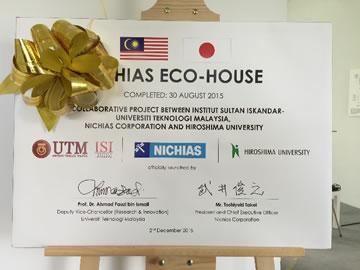
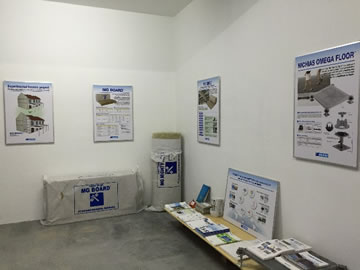
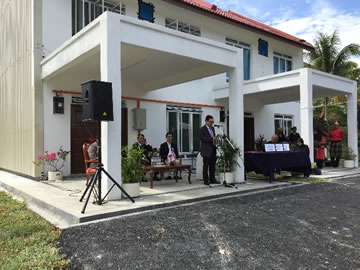
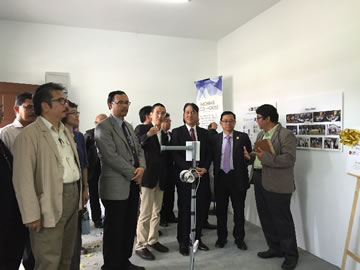
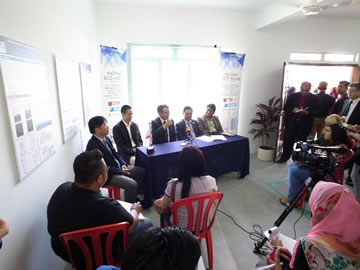

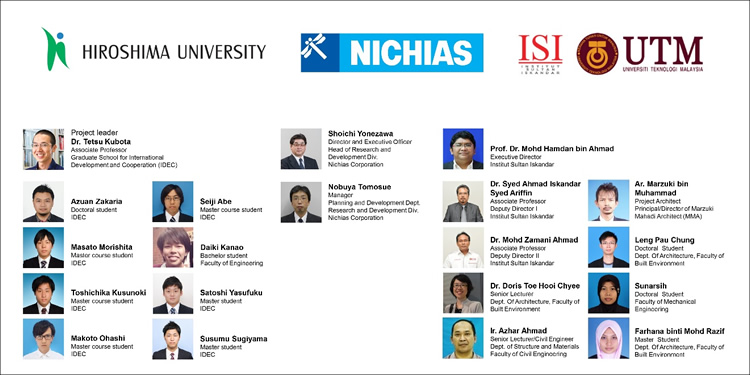
Field measurement in Malaysia (Nichias Eco House, UTM): Phase 2
Last year (2015), the first phase of field measurement was initiated in the experimental houses (Nichias Eco House) to investigate its indoor thermal condition with and without the end wall insulation (insulation on the external surface of sidewall) under several natural ventilation strategies. As has been mentioned in the previous article, the purpose of the end wall insulation is to replicate the typical terraced houses' conditions which are built in a row of three or more houses. The results showed that the insulation successfully reduced the external surface temperature of the end wall and the heat flux flow of both and walls (East and West end wall) became nearly the same. Thanks to the insulation, the surface temperature of both internal surface of end walls and party walls (the walls between both houses) also became nearly the same. Therefore, the current experimental houses can replicate the typical terraced houses' condition.
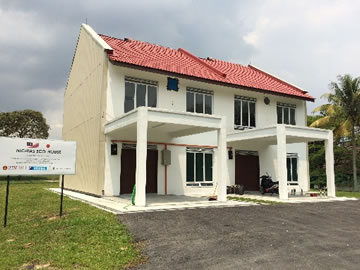

In the meantime, we are carrying out the second field measurement in these experimental houses which is scheduled from April until the end of June 2016. In this phase, the objective of the measurement is to obtain the thermal condition of the experimental houses with several passive cooling strategies and forced ventilation techniques.
The selected passive cooling techniques are (1) external wall insulation, (2) external shading of windows, and (3) roof insulation. These techniques were selected based on the results of computer simulation (TRNSYS). In the simulation, these techniques showed the best performance out of several other strategies to provide better indoor thermal condition under fully natural ventilation strategies. Meanwhile, the forced ventilation techniques are (1) the whole house ventilation fan and (2) supply fan in the master bedroom.
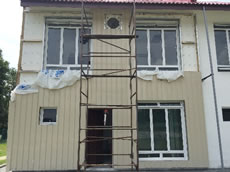
External wall insulation
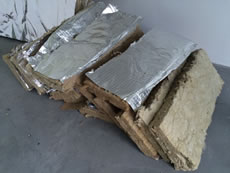
Insulation material (Rock wool)
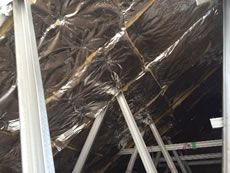
Roof Insulation

Supply fan in the master bedroom

Ceiling fan
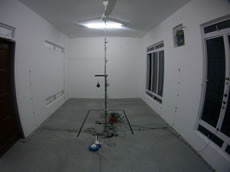
Whole house ventilator
In summary, we will investigate the actual effects of the passive cooling techniques and the forced ventilation techniques on the indoor thermal comfort. This is a very interesting experiment because we have an opportunity to test out them in an actual condition. Hopefully we could get very good findings to share with others. Thanks a lot to Kubota sensei for his continuous support in this measurement. Also, many thanks to Malaysian team (Group A) in Hiroshima University, Universiti Teknologi Malaysia (UTM) and Nichias Corporation for their contribution in this research.
New Chapter Begins! (by Tetsu)
Five new members have joined BUESA!
They are Sophia, Yawen, Ida, Nishimura and Nozoe. Now we have 16 members from 6 different nations from various parts of the world!
This year will have three research clusters comprising seven research topics such as energy-saving modification for Malaysian modern houses, passive techniques in vernacular architecture, energy-saving strategies for middle-class apartments in Indonesia, window-opening behavior in the tropics, affordable houses for urban poor, and urban heat islands in the topics, etc.
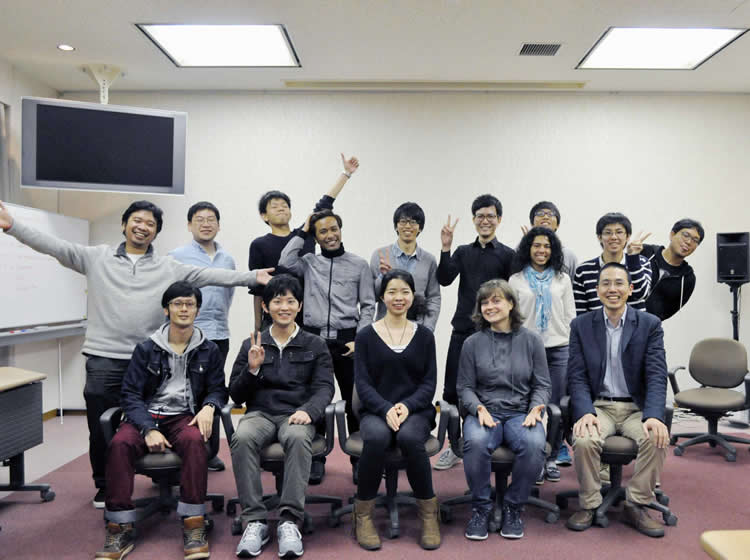
Field Measurement in Malaysia (September to October 2015) (by Group A)
In Malaysia, terraced houses have the largest share in the existing housing stocks. It accounts for more than 40% of the total housing stocks, which is larger than the other types, such as detached houses, apartments, shop houses, etc. This trend is expected to continue in the future as the main residential type. However, the use of large thermal mass building materials, such as brick and concrete, along with the lack of natural ventilation often results in hot indoor conditions particularly during night-time. This leads to the excessive use of air-conditioning, especially during the sleep time. In response to this issue, further study to find the alternative passive cooling strategies for the terraced houses are required to provide better indoor condition and low energy consumption.
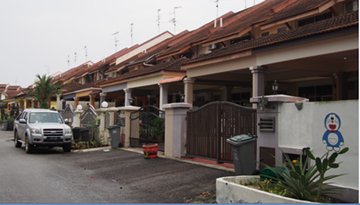
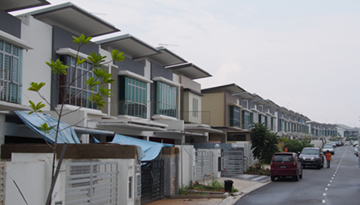
A joint research entitled 'Comprehensive Passive Cooling Techniques for Terraced Houses in Hot-Humid Climate of Malaysia: Construction of experimental houses in UTM Skudai Campus, funded by Nichias Corporation' was formed since year 2012. In this joint research, three parties were involved, Hiroshima University, Universiti Teknologi Malaysia (UTM) and Nichias Corporation, Japan. The aims of this joint research are to develop the passive cooling techniques to reduce the energy consumption in the terraced house and also to develop the guidelines for energy-saving as a proposal to the Malaysian Government. Two units of terraced houses were constructed in UTM as experimental houses in the late September, 2015.

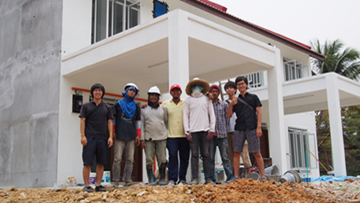
In the meantime, we are carrying out a field measurement in these experimental houses which is scheduled from September until the end of October 2015. In this phase, the objective of the measurement is to obtain the thermal condition of the constructed experimental houses with and without the end wall insulation under several ventilation strategies. End wall insulations are needed to replicate the typical terraced houses conditions which are built in a row of three or more houses.
In addition, a brief measurement was also conducted to investigate the occurrence of condensation problem in the insulation layers. For this purpose, a small sample of the end wall was constructed and installed with the insulation system. From the current result, we found that there was a possibility that the condensation would occur in the insulation layer. Therefore we came up with a countermeasure against condensation and applied it to the actual walls.
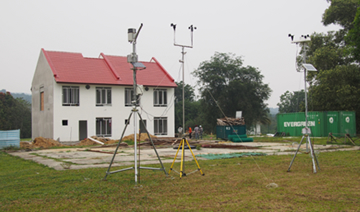
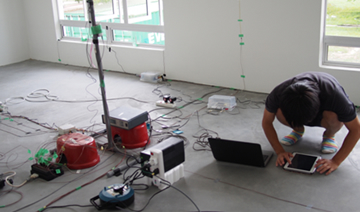
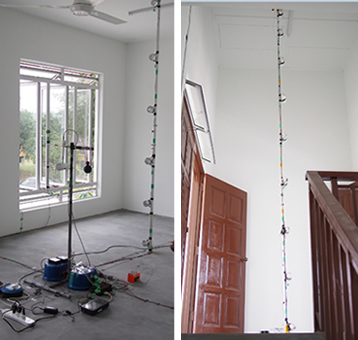
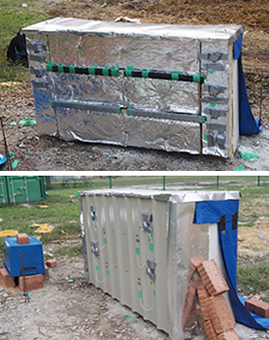
The first measurement will be ended by the end of this October 2015. This schedule was settled due to a rainy season which is expected to begin from November until January next year. We will continue the experiment next year. There are still many interesting measurement cases that can be investigated.
Field Measurement in Dutch Colonial Buildings in Bandung, Indonesia (by Group B)
With a long colonialism history in Indonesia, Dutch people had developed architectural styles that adapt to the hot-humid climate in Indonesia. And now, Dutch colonial building in Indonesia is considered to be one of architecture styles that able to prove good indoor thermal environment in Indonesia, compared to other architectural styles (modern buildings and traditional architectures). In order to develop good indoor thermal environment (and energy saving) for middle class apartment in Indonesia, we need to learn from Dutch colonial buildings, particularly in how they develop passive cooling techniques for hot-humid climate.
In summer this year (2015), we conducted field measurement in Dutch colonial buildings in Bandung, Indonesia. Bandung is well known as “a living museum” for Dutch colonial buildings. Many types of architectural styles were developed in Bandung, particularly since the 19th century to the end of Dutch era (1942). In Bandung, we can easily find the buildings with Indische Empire style (or Dutch Indies), Transitional architectural style, modern style (such as Art deco, Nieuwe Bouwen, Indo-Eurepesche Architectuur Stiijl, International style,and so on), and other architectural styles.
The field measurement was conducted from early September 2015 and will be end at the end of October 2015. The field measurements have been conducted in three Dutch colonial buildings that relatively did not change by time. They were SMAN 3 Bandung (Senior High School), SMPN 5 Bandung (Junior High School), and Gedung Gas Negara. SMAN 3 Bandung was former building of Hogere Burgerschool (HBS) te Bandoeng and was built at 1916 by Wolf Schoemaker while SMPN 5 was former building of Meer Uitgebreid Lager Onderwijs (MULO) te Bandung and was built at 1920. Meanwhile, Gedung Gas Negara (GGN) was built at 1930 by RLA Schoemaker and was used to be N.V Nederlandsch-Indische Gasmaatschapiij (NIGM) building.
The main purposes of this field measurements are to investigate detailed indoor thermal environment in Dutch colonial buildings and find out passive cooling strategies used by them in order to cope with hot-humid climate conditions in Indonesia. Those buildings are very unique with special features that very interesting to be investigated. All of the selected buildings have very thick wall (around 30-40cm) and high ceiling (averagely 5.6m) with many openings (windows, ventilation holes, and soon). SMAN 3 has one-sided corridor space alongside the building while SMPN 5 has two-sided corridor space. Meanwhile, GGN was equipped with relatively large void space in the center of the building. These features are believed to have implication on creating good indoor thermal environment.
The field measurement in Dutch colonial building is very challenging and interesting. Thanks to Kubota Sensei and Indonesia team member (Takashi Hirose and Naoto Hirata), we can do field measurement very well. This research was also fully supported by Research Institute for Human Settlements (Puskim), Ministry of Public Works of Republic Indonesia. While doing field measurement, BUESA members also could enjoy Bandung. Fortunately, those buildings are located in the downtown of Bandung (even GGN is located in Jalan Braga, the most famous street in Bandung).
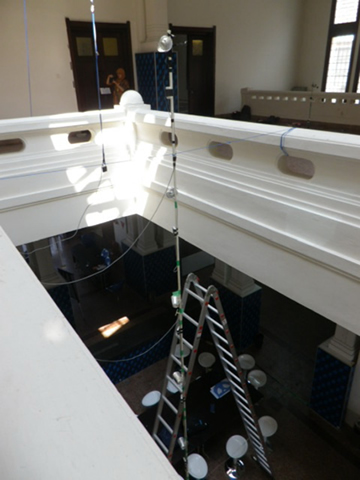
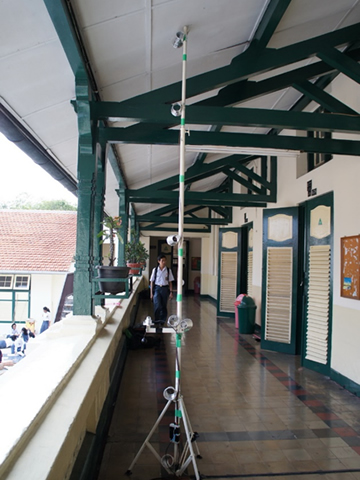
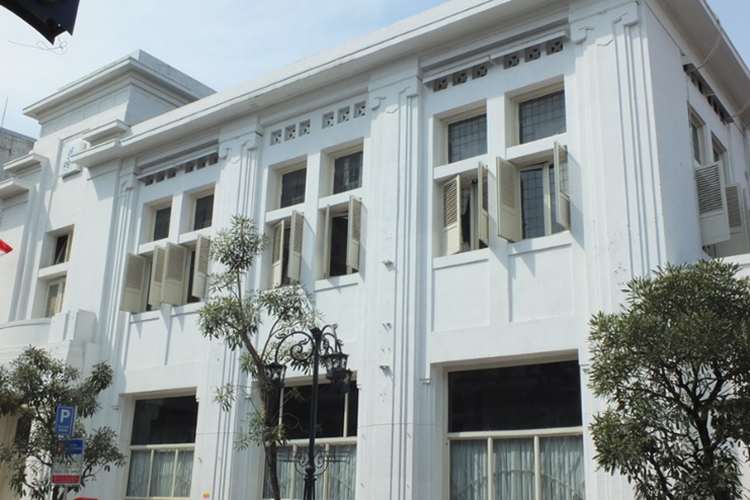
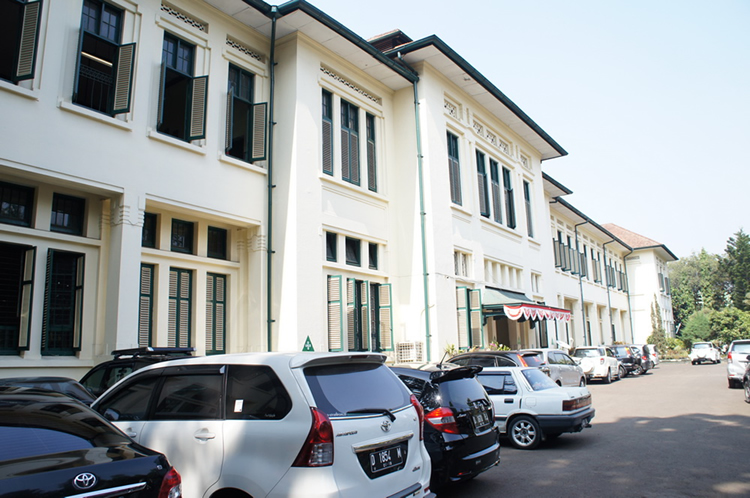
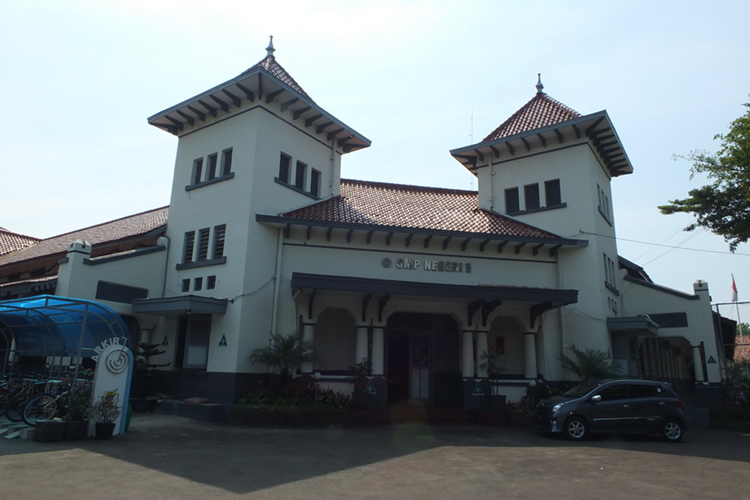
Field Survey in Bandung, Indonesia (by Morry and Shigekane)
There is concern that the spread of air-conditioners among middle-class apartments in Indonesia will contribute to the further increase in CO2 emission in the near future. It is important to encourage the occupants to open their windows for passive cooling to avoid the excessive AC use. We are carrying out the field survey in Bandung from September to October, 2015. The main purpose of this survey is to understand the architectural features around openings (such as windows, doors, eaves, etc.) and the usage of them in order to shade sunlight and to get natural ventilation. There are many types of residential buildings such as public apartments, private apartments, kampong houses, colonial houses, and so on. We are conducting face-to-face interviews to the occupants of them about their openings, consciousness, window-opening behavior, and the usage of air-conditioner(s) and fan(s) with the help of the students of UPI which is the national university in Bandung. The result of this survey will help us to consider the form of opening suitable for their lifestyles and the hot-humid climate. We appreciate all people for helping our survey, especially Kubota-sensei, Usep-sensei, and the students of UPI.
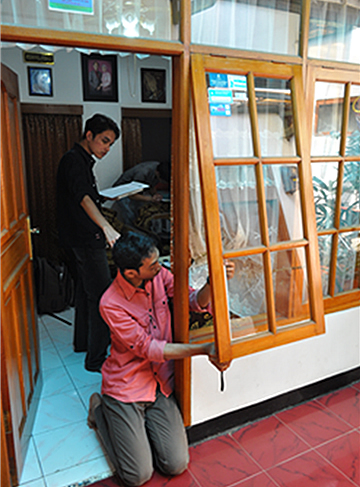
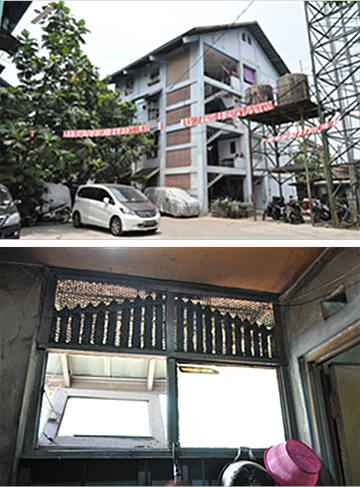
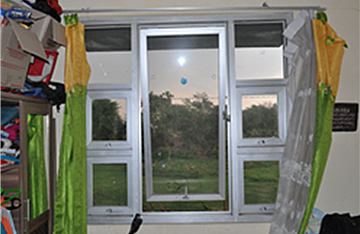

Diverse BUESA! (by Tetsu)
Eight new members have joined our research group!
They are Kent, Hiroto, Takashi, Daiki, Makoto, Su Su, Dulguun and Morry. They nicely increased our diversity. Now we have 18 members from 7 different Asian countries and of different ages and occupations, etc. I believe that diverse environment is the best to grow a strong person.
Now we have four research clusters: (1) Experimental house in Malaysia, (2) Passive cooling in Indonesia, (3) Household energy and QOL in Asian developing countries, and (4) Urban heat island in the tropics.

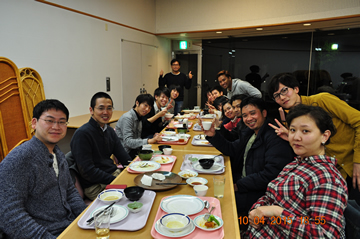
Field Measurement in spring in Hanoi, Vietnam (by Tung)
As mentioned in the previous article 'Field Measurement in Hanoi, Vietnam', the urban row houses in Hanoi have many weaknesses such as overheating in summer and severe condensation in spring. We successfully conducted a field measurement in summer and we obtained some nice findings.
In order to have better understanding on overall indoor thermal condition, the second investigation was conducted. The main objective of the field investigation is to observe the condensation phenomenon. Condensation occurs when the surface temperature is lower or equal to the dew point temperature, leading to the transformation of water vapor to water on the surfaces. As a consequence, mold growth and respiration-related diseases spread.
The field measurement was carried out in March 2015. The main purpose was to investigate the indoor thermal conditions in spring at the same houses as in the summer measurement. In parallel with the measurement, the daily activities of occupants were recorded to understand the responses of occupants toward this phenomenon. The main aim of this research is to understand the causes of condensation phenomenon and give some recommendations to the owners and architects on how to manage or at least eliminate it.
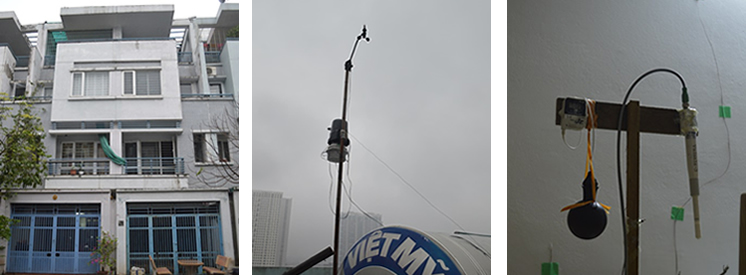
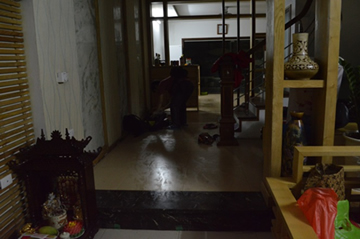


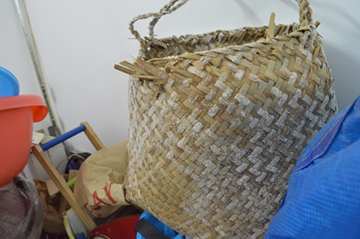
Beside the measurement, the authors also visited the new town city, which is considered to be the "face" of Hanoi in the future.
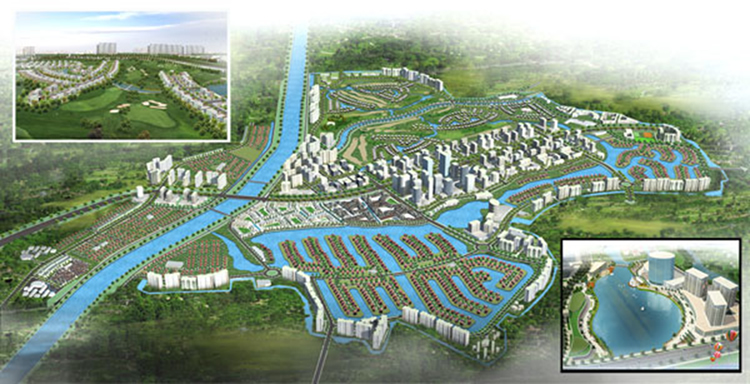
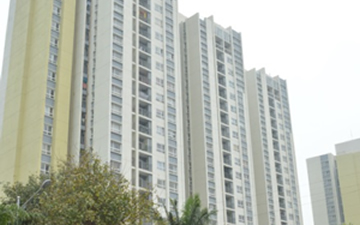
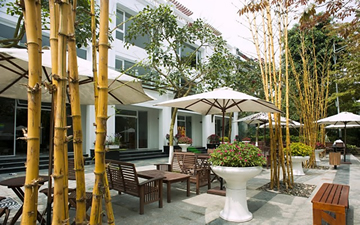
Finally, I would like to express my gratitude to everyone involved in this project, foremost to Kubota-sensei and the owners of the measured houses.
Urban Heat Island Workshop in Hanoi (by Andhang)
In March 2015, we visited Vietnam Institute of Urban and rural Planning (VIUP) in Hanoi, Vietnam. It was our second visit to that institution. The first visit was held back in 2013. In the first visit, we presented the assessment of urban heat island (UHI) in Hanoi under the condition of before and after the implementation of Hanoi Master Plan 2030. At that time, the group of executives of VIUP gave as inspiring ideas and suggestions for mitigating UHI in Hanoi City. We brought back those ideas to our lab and worked on them intensively. Then, in 2015, we visited VIUP again by bringing new findings.
The objectives of our second visit is to show our idea for mitigating UHI in Hanoi. Unlike the first meeting, the second meeting brought more attention to the people in VIUP. Our second meeting was attended by about 30 participants consisting of the head of divisions and young staffs of VIUP. During the discussion, we received many questions and comments that would improve our research. We really appreciate comments and suggestions given from the staffs of VIUP because we know that they know deeply about their city better than us.
In general, we received a positive response from VIUP. They are really keen to include our methodology to their urban planning projects. Furthermore, our idea for mitigating UHI in Hanoi will be strongly taken into consideration in the master plan.
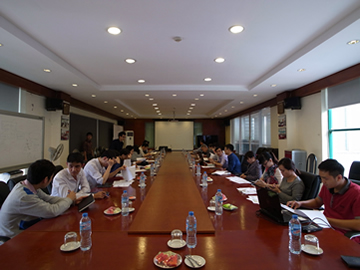
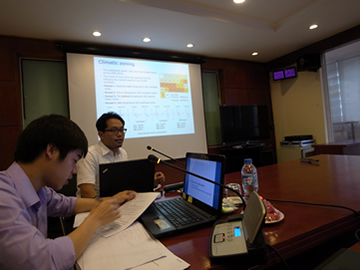
IDEC Graduation Ceremony (by Tetsu)
IDEC is busy. This is simply because we have both admission and graduation twice a year. However, this graduation was indeed one of the most memorable ones for me and for BUESA. Our long-term leading members, Satoshi, Susumu, Makken and Jeong, graduated from BUESA and IDEC this time!!
They again dominated the podium (no.1, 2 and 3!) in the final presentation! Makken, Susumu and Satoshi were the most improved students in my teaching history. They became almost fluent in English during the short period of time, surprisingly. I can say they became the first high potential global leaders from BUESA. Jeong was the original member of BUESA since it was established. He has been leading our group since then. All of four students whom I am proud of have bright futures ahead!
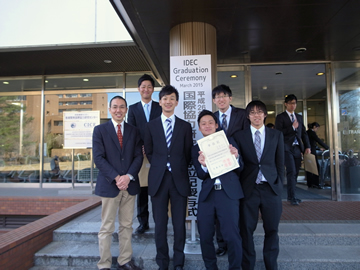
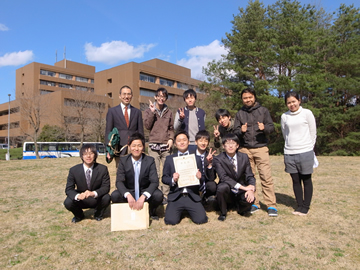

IDEC Graduation Ceremony (by Tetsu)
I was taught by my previous supervisor that a university is just like a platform in which people are just passing by. Students are coming in and leaving out at the same time just like a river flow.
In this time, five students graduated from our research group, BUESA. They made great achievements. Usep finally obtained his Doctoral Degree after passing several tough oral examinations. He left for Indonesia in September for his new assignment in his university, Indonesian University of Education. I believe he would become a thoughtful educator in his university based on his experiences that he had during his Ph.D.
Our Master graduates were also really great. They dominated the podium in the IDEC final presentation! Andhang was awarded the excellent thesis award by our department (No. 1), Meita was the runner-up, and Nam was the third! Their presentations were really enthusiastic and deserve the praise. Andhang decided to pursue his study until the Ph.D level (he will extend his study further and further). Meita went to Tokyo and joined one of the leading design ateliers to learn the world-class architectural design. Nam went back to his Institution (National Institution of Architectural Planning) in Hanoi. He will reinforce his profession of architect by adding the sense of building science.
Jochen also finished his six month stay in BUESA and resumed his Master's research in Graz. He performed very important tasks in one of our research projects (UHI study) and very positively influenced all of our members during his stay. He would complete his interesting thesis in collaboration with our research group.
The last semester was something very special for me and (I believe) for all the members of our group. I am confident that all the above graduates would succeed in their new environments!

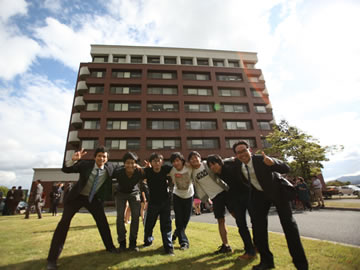
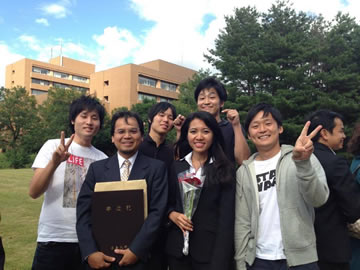
Field measurement in Hanoi, Vietnam (by Tung)
With a population of over 6.4 million, Hanoi is considered to be one of the densest and largest cities in the world (Hanoi master plan, 2011). For that reason, investigating the impact of global climate change and urban heat island to thermal comfort of residents is a necessity. In this particular research, the author focuses on studying the row houses, considering the fact that 69% of Vietnamese homeowners utilize this kind of house (Matt, P., 2013). Moreover, this type of house is trending greatly among the middle and upper class in Vietnam, especially in Hanoi. However, under a specific climatic condition and hot-humid climate, row houses in Hanoi reveal many weaknesses such as hot temperature during the summer and condensation in early spring. To evaluate these problems, on-site investigations during these periods are conducted.
A field measurement in Hanoi was carried out from August until September 2014. The main purpose is to investigate the indoor thermal condition in modern row houses during the summer time. In this trip, the author designated a 2-week period to visit each of the four row houses and recorded the indoor thermal conditions as well as the daily activities of the occupants. The main aim of this research is to evaluate the thermal comfort and condensation in modern row houses and finally, to provide recommendations to the owners and stakeholders on how to deal with or eliminate these issues.
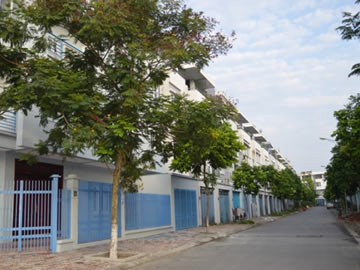
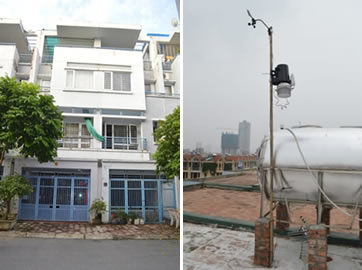
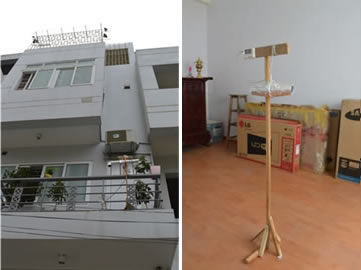
Besides conducting a measurement in a modern row house, author also visited a vernacular row house which was developed during the French colonization. This type of house is considered to be able to respond to local climate better than the modern houses.
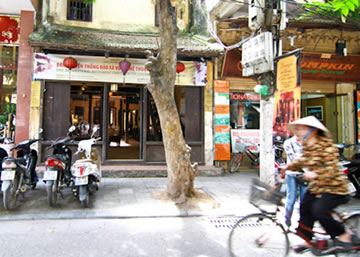

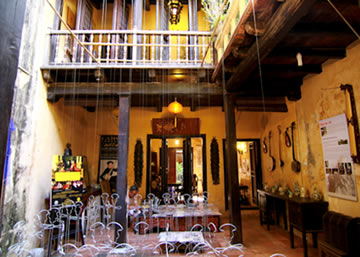
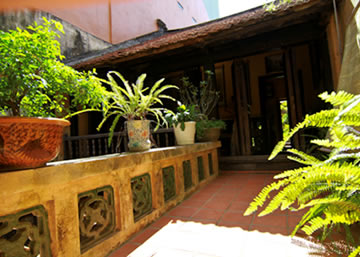
Finally, I would like to express my gratitude to everyone involved in this project, foremost to Kubota-sensei and the owners of these houses.
BUESA on Grand Renewable Energy 2014 (by Andhang)
The Grand Renewable Energy 2014 (GRE2014) International Conference 2014 was held in Tokyo, Japan, from July 27th to August 1st, 2014. GRE2014 carried out extensive activities, essentially because the wide number of topics covered and they bring together leading scholars and academia, industry, and government, not only from Japan but also from various countries of the world. By giving a chance for students to present their research, GRE2014 also want to develop young generation with global sense through the refined paper submission.
Four members of BUESA which are Azuan-san, Kenji-san, Meita-san and Andhang had a chance to present their own research in front of experts, researchers, and students. Jochen Kraus, our visiting member from Germany, was also attending the conference for listening to various interesting presentations about sustainable development. On July 28th, Azuan presented in the oral session of vernacular architecture/passive design. He explained a review about environmental design consideration for courtyards in hot humid climate. On the next day, Kenji-san and Andhang-san had a chance to present their research in the oral session of environment and heat pump. Kenji-san nicely delivered his presentation entitled "Analysis of factors affecting Quality of Life (QoL) of residents in Bandung towards balancing between QoL and household energy consumption", while Andhang presented his study about the effects of green strategy proposed in the Hanoi master plan on its urban climate. Meita-san became the star of the event when her poster entitled "A field survey of window opening behavior and environmental conditions in apartments of Surabaya" was successfully awarded as the Best Poster Presentation in the conference!
Attending a conference provides us a chance to meet people who are interested in the same topic of research and discuss theoretical and methodological ideas. Many presentations could inspire us with new ideas and we could learn more about areas of our discipline that are not researched in our laboratory.
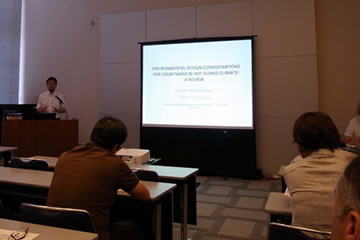

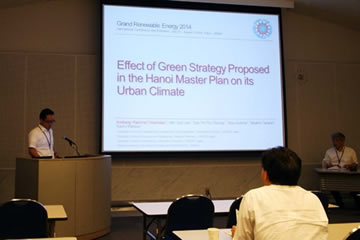
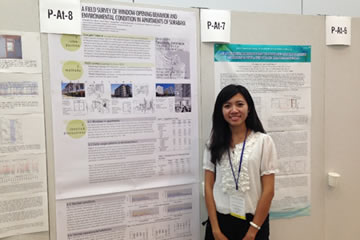
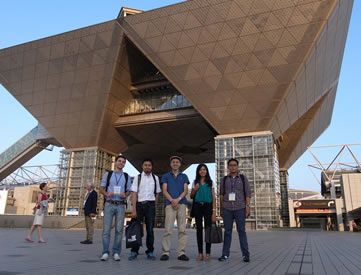
BUESA is growing!
It has been only five years since BUESA was established. No one expected that we would grow so nicely. This time, we accepted five new faces from Indonesia, Japan, Germany and Austria. Moreover, one of our original members, Jeong-kun, has come back from Korea! (Tetsu)
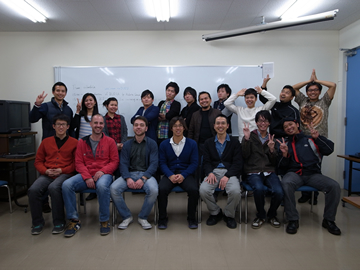
Four members have departed from BUESA!
The graduation ceremony was held in a hotel in city of Hiroshima. They are showing the certificates with confident faces. Two of them, Kusunoki-kun and Morishita-kun, will enter the IDEC (Master's course) directly. Nagao-san will join a housing company in Kyusyu, Japan. Wakisaka-kun is going to U.K. soon to pursue his Master's study. We wish all will succeed in the new environments! (Tetsu)

The New Chapter is now opened!
IDEC has two admission months, April and October. Our research group, BUESA, accepted three freshmen from Malaysia, Vietnam and Cambodia (Azuan-san, Tung-san and Ousa-san). Now we are group of 16 members (and therefore three members were in overseas when this picture was taken). These energetic students are stationed in four rooms in IDEC separately but nicely. Since we usually do a field work in somewhere in Asia as introduced below, it is a bit difficult to gather all together nowadays ^^. (Tetsu)
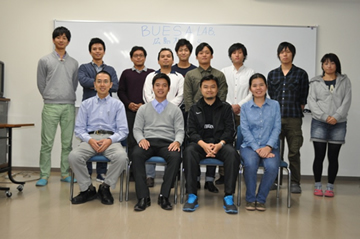
Before
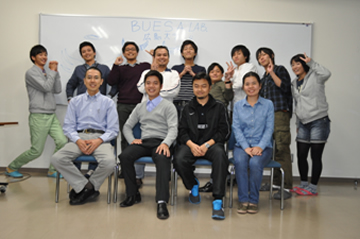
After
Field Trip to Bandung, Indonesia (Matsunaga and Nagao)
A field trip to Bandung Indonesia was carried out in September 2013. The aim of this trip is to survey the actual condition of the building's environment and windows of urban houses in Bandung, Indonesia. Bandung is one of the most developed areas in Indonesia so it is crowded with so many buildings such as residential buildings and commercial facilities. On the other hand, Bandung is blessed with a richness of nature because it is surrounded by mountains. The climate is relatively cooler than other cities in Indonesia due to the high altitude, therefore the city is popular as a summer resort.
Since 2011, we have conducted the study of life cycle assessment (LCA) and quality of life (QOL) for residential building in Bandung in cooperation with ITB and UPI, which are the national university located in Bandung. This field trip was carried out as a part of these studies. In this trip, we conducted an interview and some measurements of windows and building environment, i.e. temperature, humidity, globe temperature, noise level and illuminance by visiting the residents with the help of students of ITB. Through this survey, we could have a glimpse for the actual life of the people who lived in Bandung and it was very fruitful for us. Finally, we are grateful to all people who helped us, especially Kubota-sensei, Hanson-sensei and students of ITB.
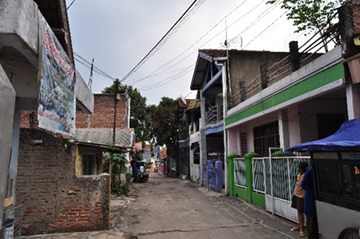

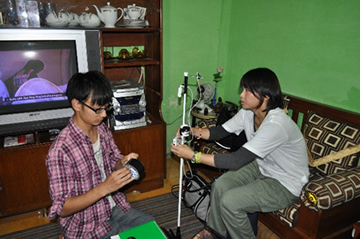
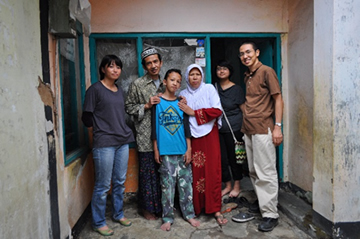
Field Trip to Surabaya, Indonesia (Meita)
A Survey in Surabaya was carried out during September to October 2013 under joint research project with University of Brawijaya and Sepuluh November Institute of Technology. The main purpose of this survey is to conduct questionnaire survey for apartment building users as well as measurement for one-week indoor thermal condition. Around 7 public apartments and 5 private apartments were covered. Nowadays, the development of urban areas results on high density and limitation of available land for greeneries. Thus, big cities in Indonesia currently expanding the construction of vertical houses rather than landed one. It is expected that more vertical houses will be constructed in the future. Result of this survey will help us to see how this may affect housing development in Indonesia in terms of energy consumption and thermal comfort of particular building users. Afterward, a comparison with landed houses will be made to see the differences and to estimate the future projection of housing, energy, and comfort in living environment in big cities in Indonesia.

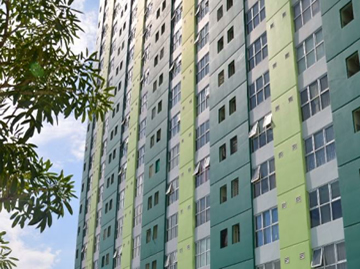

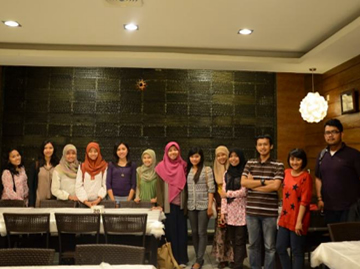
Besides survey project, a visit to colonial buildings was made. It was really interesting to see how Dutch colonization not only leaving pain, but also remarkable architecture that adapt to tropical climate of Indonesia.
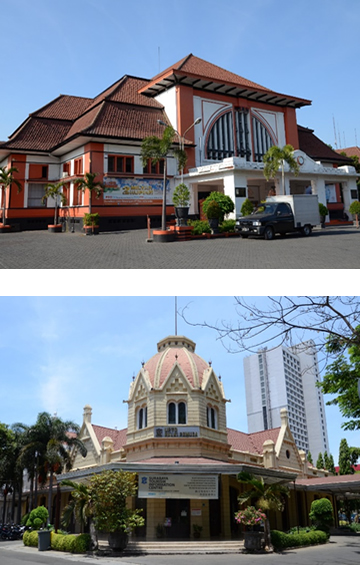

Field Trip to Hanoi, Vietnam (Andhang)
In September 2013, we had a visit to Hanoi, Vietnam. This visit purposed as s continuation of the Urban Heat Island (UHI) project in which have collaboration with Vietnam Institute of Architecture, Urban and rural Planning (VIAP). We conducted a small meeting with VIAP to discuss UHI issue and seeking for a solution to mitigate the problem for the future Hanoi Master Plan. Hanoi becomes an interesting study area because its rapid economic growth which goes along with high rate of urbanization have been inducing higher temperature in the urban area compared to the rural area. It might give impact to energy demand in the future, especially energy for cooling coming from the building sector. However, there were lack of study about these issue in many big cities in Southeast Asia.
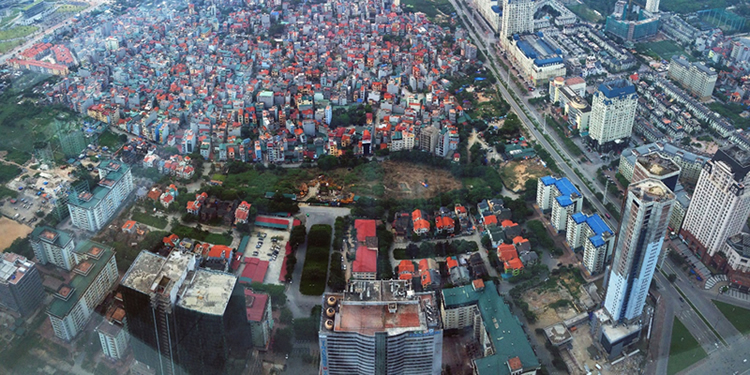
Apart from that, Hanoi is a fascinating city with the long history which shapes the city today. The rich cultural heritage has influenced the daily-life, culinary, architecture and the cityscape. We were surprised to see that the Hanoians love spending time for outdoor activities such as enjoying Vietnamese coffee and delicious Pho noodles at the street vendor while a large number of busy motorcycles passing by.
The unique slim building (tube house) with the width less than 3-4 meters is everywhere in the city. How can you imagine the occupant finds comfort inside that narrow space? Not to forget, the existence of the old big trees along the street provide you a cool spaces under the Hanoi's sunny day.
We had chance to visit the newly built highest building in Hanoi, named Keangnam tower. It is 72-story with the height of 350m, equipped with observation deck on its top floor where we can have 360o aerial view of the current condition of the city. We also visited National Urban Planning Exhibition Hall (NUPEL) where we can see the big scale model showing the Hanoi Master Plan. By looking at the model, it gave us a clearer view of Hanoi in the future.
We are really impressed with Hanoi's cityscapes. It is still maintaining the heritage and the old buildings while keep moving forward with modernization. Together with kind support and cooperation given by VIAP, we are so excited to see the outcome of the research works soon.
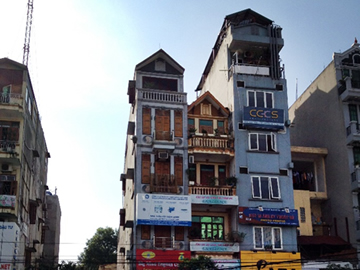
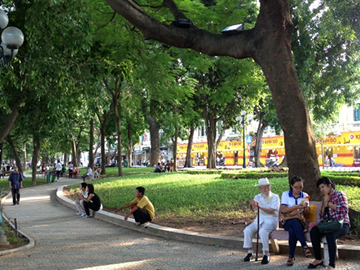


Field Trip to Phnom Penh, Cambodia (Motoki)
A field trip to Phnom Penh was made in May and October 2013. The main Purpose is to carry out the workshop which are based on outdoor learning activity adopting the water quality monitoring with elementary school children. This study's final aim is to develop a new outdoor environmental education program as a part of formal primary education in Cambodia. In the workshop, 37 children were taken to the riverbank near the school in order to let them experience the field measurement. In Cambodia, there is no outdoor activity in school curriculum. Therefore, this activity was the first experience for the children. Many of them were very excited. Finally, the workshop ended up successfully.
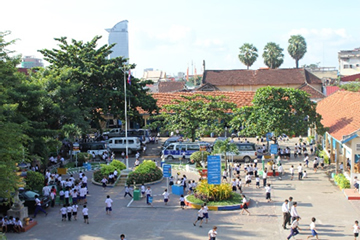


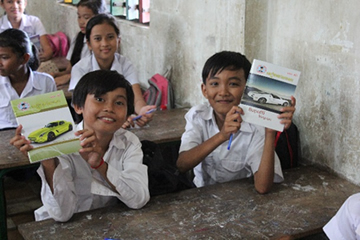
Sightseeing
During the stay in Phnom Penh, I visited several popular and historical places in Phnom Penh to understand Cambodian culture. I will introduce some of them.
Sightseeing: Royal Palace,
The Royal Palace is a complex of buildings which serves as the royal residence of the king of Cambodia. The Kings of Cambodia have occupied it since it was built in 1860's, with a period of absence when the country came into turmoil during and after the reign of the Khmer Rouge

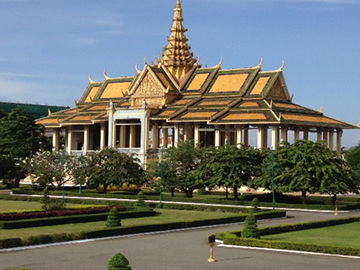
Sightseeing: Tuol Sleng Genocide Museum
Tuol Sleng Genocide Museum is a museum in Phnom Penh, the capital of Cambodia. The site is a former high school which was used as the notorious Security Prison 21 (S-21) by the Khmer Rouge regime from its rise to power in 1975 to its fall in 1979. Tuol Sleng was only one of at least 150 execution centers in the country, and as many as 20,000 prisoners there were killed.
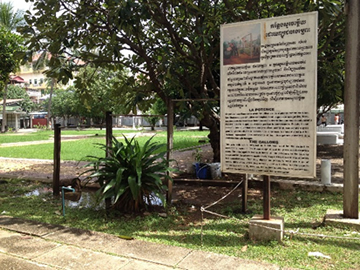

Sightseeing: Independence Monument
The Independence Monument was built in 1958 for Cambodia's independence from France in 1953. It is in the form of a lotus-shaped stupa, of the style seen at the great Khmer temple at Angkor Wat and other Khmer historical sites. The Independence Monument was designed by the influential Cambodian modern architect Vann Molyvann. During national celebrations, The Independence Monument is the center of activity.
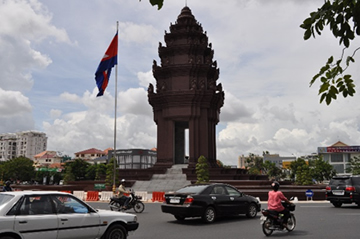
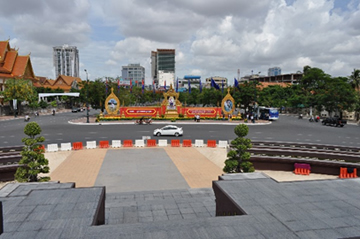
The New Year begins!
April is something special in Japan. This is still the exact starting month of Japanese academic calendar.
We had a good start with four new students with blooming Sakura trees. They are Kusunoki-kun, Morishita-kun, Yuko-san and Motoki-kun. Our research group, BUESA, is growing and is now probably one of the peaks in its history. I feel this year is going to be the most productive year we've ever had.

Field trip to Tokyo, Japan – Architectural View (by Andhang and Meita)
The field trip to Tokyo was held on March 13th to 15th, 2013. The aim of this trip is to understand the development of sustainable architecture and urban planning in the main city of Japan. The objects of study were comprises of mainly museums and commercial buildings, i.e. Tokyo Edo Museum, Ueno Park and Museums (Tokyo National Museum, National Museum of Western Art), The University of Tokyo, St. Mary Cathedral, Yoyogi National Stadium, Shibuya and Omotesando, Meiji Temple, Tsukiji Fish Market, Tokyo Sky Tree, Odaiba, and Yokohama). In this trip, research members was studying Japanese architecture by comparing traditional and modern architecture of Japan, including the change and development between two particular architectures. It is interesting to see how diverse these distinct architectural design has been imprinted, which in several cases still maintain to show connection between the past and the present.
Understanding the Past: Meiji Temple, Tokyo Edo Museum, and Tokyo National Museum
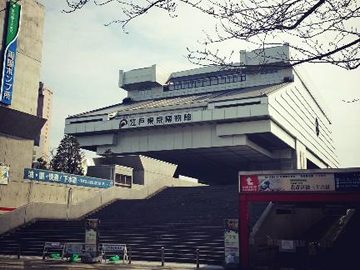
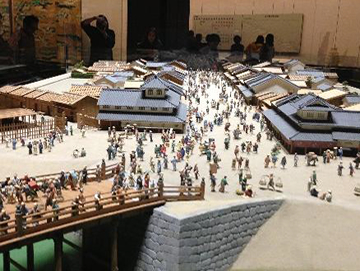
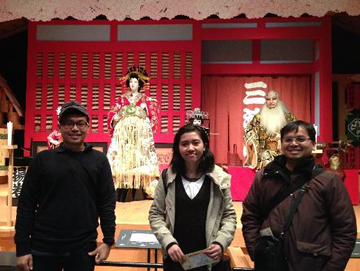
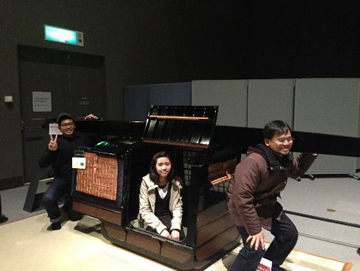
Tour inside the museum and temple gave more understanding about how architecture in Japan has developed in harmonious with its society since Edo Era up until reconstruction after World War II. At Tokyo Edo Museum, the history of Tokyo was nicely displayed through models and diorama so we can easily imagine the societies, architecture, and daily life at that time. By observing from both modern and traditional perspective made us clearly understand how Tokyo could become the busy and complex city in the world with its exotic and ultra-modern architectures but still comfortable enough to be lived in.
Modern Architecture of Japan: St. Mary Cathedral, Shibuya, Yokohama Port, Tokyo Sky Tree, and Yoyogi National Museum
Modern Architecture has penetrated Japan just after World War I, marked by the erection of International style Yoyogi National Museum by Kenzo Tange.
In between; the relation of the two: Omotesando Hills
Omotesando Hills is one of remarkable designs by Tadao Ando which considered successful at maintaining the relation between the past and the future.

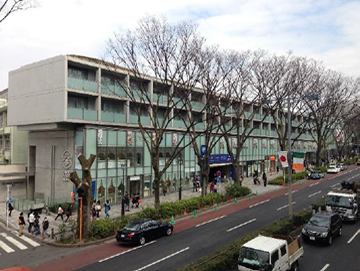
Field trip to Malacca, Malaysia
A field trip to Malacca, Malaysia was made in October 2011. The main purpose is to carry out a field measurement of indoor thermal environment in selected traditional Chinese shophouses in the core heritage zone of the Historic City of Melaka. As known widely, the Historic City of Melaka has been inscribed by UNESCO as a World Heritage Site (together with George Town, Penang) in 2008. Needless to say, as a place rich in cultural heritage, there are many cultural elements to see and experience amidst serious research works. These include the unique old streets with the spectacular shophouses and other historical buildings, authentic local specialties and an artistic community, where an artist sketched an impromptu portrait of one of us! It is truly the warm and friendly local people, including all those we worked with, who made our experience great and our research works possible.
